| Author |
Message |
|
Al Muckart
|
 Posted: Tue 10 Jun, 2008 8:59 pm Post subject: Looking for examples of medieval engravings on swords Posted: Tue 10 Jun, 2008 8:59 pm Post subject: Looking for examples of medieval engravings on swords |
 |
|
Hi all,
I am looking for examples of engravings on late medieval swords. I've worked out the final design details with Peter Lyon for the sword I am getting made, but I would like to get it engraved.
I have the words already, but they don't fit neatly on the quillons. The sword will have a rainguard so the engraving can't just go all the way across. I'll sacrifice the engraving before I go without the rainguard (which will also be decorated with i.h.s on one side and either "maria" or d.g. on the other).
From what Peter has said engraving on the blades of swords of this period is rare to nonexistent because it predates acid etching but the blade steel was hard enough to make engraving the blades impractical. Aside from that I rather like the aesthetic of the unadorned blade.
The text I want to get engraved is:
| Quote: |
Ubi perexeris pergam
|
| Quote: |
moratus fueris morabor
|
One one each side of the sword with the sentence split between each arm of the cross. There won't really be space to get three words on each arm of the cross.
I would like to see other examples of this sort of engraving on sword furniture to get a feel for how best this should be laid out and divided up. The easiest way to get a feel for the size and style of the cross is that it will be of the style of the one on the Munich.
FYI the text is based on Ruth 1:16 in the vulgate latin version of the Old Testament. It was contracted down for me by a scholarly friend familiar with medieval latin and means "wherever you go I shall go" and "wherever you stay I shall stay". That passage formed the basis of our wedding vows when my wife and I got married 
Any help would be greatly appreciated.
--
Al.
http://wherearetheelves.net
|
|
   |
 |
|
Russ Ellis
Industry Professional
|
 Posted: Wed 11 Jun, 2008 6:56 am Post subject: Posted: Wed 11 Jun, 2008 6:56 am Post subject: |
 |
|
I have to agree with Peter on that one I don't recall seeing a whole lot of engraving work on medieval period swords. Mostly what I've seen have been latten (and latin) inlays and those are usually on the blade. One thing you might consider if you are having a problem with your inscriptions length is abbreviating it, that was certainly done in the inlays on medieval pieces, sometimes to the point where the meaning of the inlay is lost entirely.
TRITONWORKS Custom Scabbards
|
|
  |
 |
Sean Flynt

|
 Posted: Wed 11 Jun, 2008 7:12 am Post subject: Posted: Wed 11 Jun, 2008 7:12 am Post subject: |
 |
|
Have you considered using the inscription--with small, close-set letters-- as a border on the edges of the rain guard?Whether metal or leather, you can use gilding paint and it would look terrific. It would save you lots of time and money since there's no engraving or embossing. Decoration of the rain guard has the added advantage of being historically authentic.
 Attachment: 131.25 KB Attachment: 131.25 KB
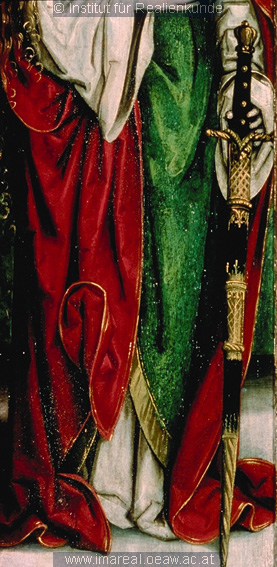
 Attachment: 105.82 KB Attachment: 105.82 KB
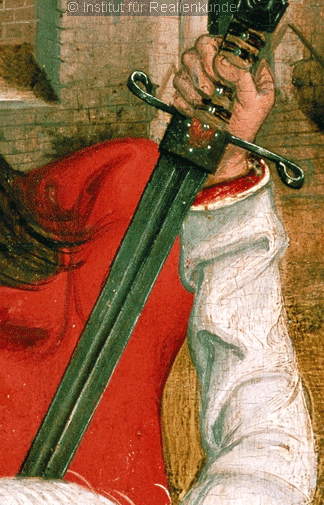
 Attachment: 99.47 KB Attachment: 99.47 KB
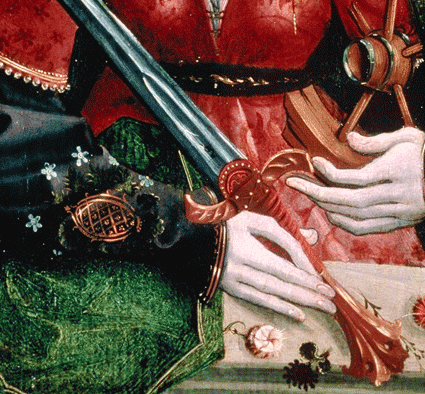
 Attachment: 55.45 KB Attachment: 55.45 KB
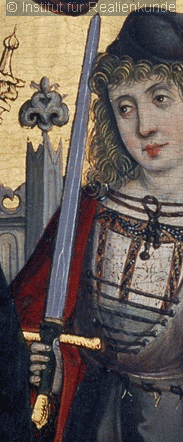
 Attachment: 123.71 KB Attachment: 123.71 KB
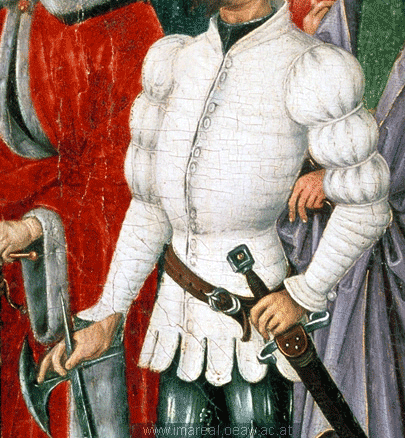
-Sean
Author of the Little Hammer novel
https://www.amazon.com/Little-Hammer-Sean-Flynt/dp/B08XN7HZ82/ref=sr_1_1?dchild=1&keywords=little+hammer+book&qid=1627482034&sr=8-1
|
|
   |
 |
|
Russ Ellis
Industry Professional
|
 Posted: Wed 11 Jun, 2008 10:48 am Post subject: Posted: Wed 11 Jun, 2008 10:48 am Post subject: |
 |
|
There's another excellent idea, and Sean please by all means continue to post pictures any time you like!
TRITONWORKS Custom Scabbards
|
|
  |
 |
|
Al Muckart
|
 Posted: Wed 11 Jun, 2008 12:18 pm Post subject: Posted: Wed 11 Jun, 2008 12:18 pm Post subject: |
 |
|
Hi Russ,
| Russ Ellis wrote: | | I have to agree with Peter on that one I don't recall seeing a whole lot of engraving work on medieval period swords. Mostly what I've seen have been latten (and latin) inlays and those are usually on the blade. One thing you might consider if you are having a problem with your inscriptions length is abbreviating it, that was certainly done in the inlays on medieval pieces, sometimes to the point where the meaning of the inlay is lost entirely. |
Wording-wise the phrases have been significantly trimmed from the vulgate already, but I'm also trying to work out correct abbreviations. Part of why I'd like to find pictures (if there are any) of extant engraved swords is to see how the abbreviations were laid out and if there are any marks indicating the termination of a word etc.
Thanks.
--
Al.
http://wherearetheelves.net
|
|
   |
 |
|
Al Muckart
|
 Posted: Wed 11 Jun, 2008 12:28 pm Post subject: Posted: Wed 11 Jun, 2008 12:28 pm Post subject: |
 |
|
Hi Sean,
| Sean Flynt wrote: | | Have you considered using the inscription--with small, close-set letters-- as a border on the edges of the rain guard?Whether metal or leather, you can use gilding paint and it would look terrific. It would save you lots of time and money since there's no engraving or embossing. Decoration of the rain guard has the added advantage of being historically authentic. |
Thanks for the pictures 
With the proportions of the sword, unless I made the rain guard really big, fitting the lettering on it is well beyond my skills to carve (I'll be building the rainguard). I can carve gothic script into leather well enough to tidily fit a "maria" onto one face of it but that's nearly as small as I can go.
--
Al.
http://wherearetheelves.net
|
|
   |
 |
|
Al Muckart
|
 Posted: Wed 11 Jun, 2008 12:30 pm Post subject: Posted: Wed 11 Jun, 2008 12:30 pm Post subject: |
 |
|
I guess the other aspect of this is that a negative is almost as useful as a positive for this project; if there is no evidence for this sort of decoration of swords of the 3rd quarter of the 15th century then I'll just decorate the rainguard and leave the engraving for another sword (it's an excuse to get another one, right  ) )
--
Al.
http://wherearetheelves.net
|
|
   |
 |
Kirk Lee Spencer

|
 Posted: Wed 11 Jun, 2008 2:07 pm Post subject: Posted: Wed 11 Jun, 2008 2:07 pm Post subject: |
 |
|
| Al Muckart wrote: | | ...if there is no evidence for this sort of decoration of swords of the 3rd quarter of the 15th century... |
Hey Al...
I wouldn't say "no evidence."
Here are a couple of fancy blades from "Armi Bianche Italiane” by Boccia, Lionello G. and Coelho, Eduardo T. 1975
This work dates them to the middle to last quarter of the 15th century.
ks
 Attachment: 86.11 KB Attachment: 86.11 KB
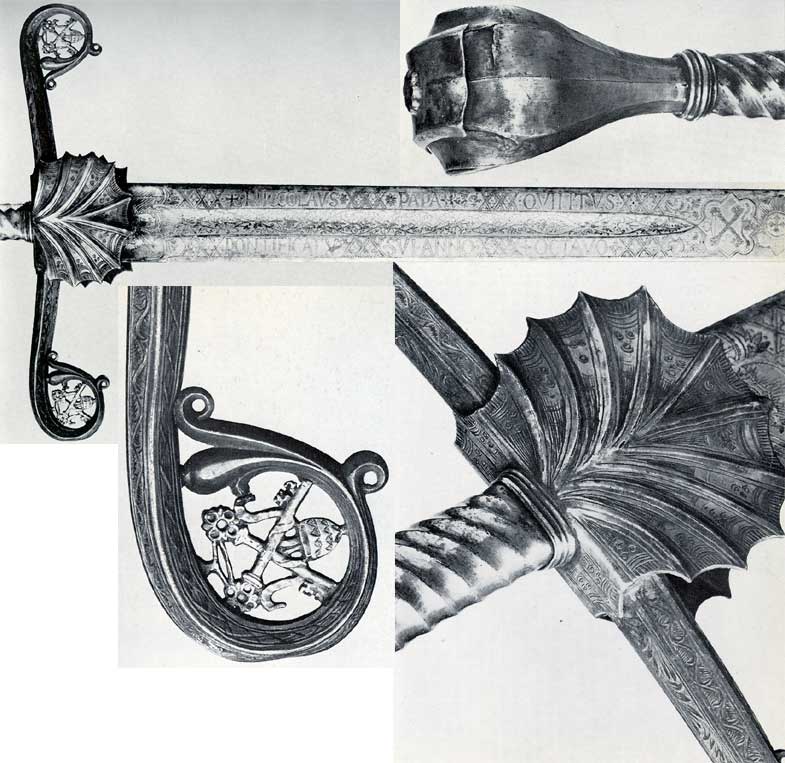
 Attachment: 71.97 KB Attachment: 71.97 KB
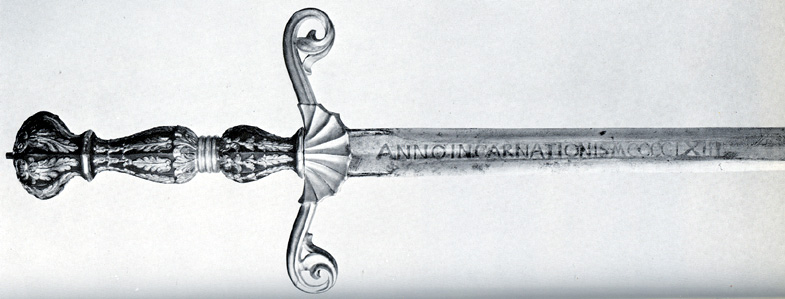
Two swords
Lit in Eden’s flame
One of iron and one of ink
To place within a bloody hand
One of God or one of man
Our souls to one of
Two eternities
|
|
  |
 |
|
Al Muckart
|
 Posted: Wed 11 Jun, 2008 2:54 pm Post subject: Posted: Wed 11 Jun, 2008 2:54 pm Post subject: |
 |
|
Hi Kirk,
| Kirk Lee Spencer wrote: | I wouldn't say "no evidence."
Here are a couple of fancy blades from "Armi Bianche Italiane” by Boccia, Lionello G. and Coelho, Eduardo T. 1975
|
Wow those are ... ornate. Thank you for posting them.
The engraving (or is it etching?) on those is fantastic. They are both stylistically quite different swords from the type I'm getting made but they're a good data point for what was being done in the approximate period.
| Quote: |
This work dates them to the middle to last quarter of the 15th century.
|
1493 if the date on the second one is to be believed. There's something about the hilt on it that says "Victorian" to me, but I can't put my finger on why, and I'm not familiar enough with the aesthetics of the 1490s to know whether that's reasonable or not.
Thanks.
--
Al.
http://wherearetheelves.net
|
|
   |
 |
|
Russ Ellis
Industry Professional
|
 Posted: Fri 13 Jun, 2008 5:25 am Post subject: Posted: Fri 13 Jun, 2008 5:25 am Post subject: |
 |
|
| Kirk Lee Spencer wrote: | | Al Muckart wrote: | | ...if there is no evidence for this sort of decoration of swords of the 3rd quarter of the 15th century... |
Hey Al...
I wouldn't say "no evidence."
Here are a couple of fancy blades from "Armi Bianche Italiane” by Boccia, Lionello G. and Coelho, Eduardo T. 1975
This work dates them to the middle to last quarter of the 15th century.
ks |
Interesting, that first one, does it provide any attribution for it in the book? Something to do with the papal guard perhaps?
TRITONWORKS Custom Scabbards
|
|
  |
 |
Chad Arnow
myArmoury Team


|
 Posted: Fri 13 Jun, 2008 6:02 am Post subject: Posted: Fri 13 Jun, 2008 6:02 am Post subject: |
 |
|
| Russ Ellis wrote: |
Interesting, that first one, does it provide any attribution for it in the book? Something to do with the papal guard perhaps? |
I believe it's a "blessed sword" which the popes gave as gifts to important supporters.

ChadA
http://chadarnow.com/
|
|
    |
 |
Sean Flynt

|
|
   |
 |
|
Russ Ellis
Industry Professional
|
 Posted: Fri 13 Jun, 2008 9:29 am Post subject: Posted: Fri 13 Jun, 2008 9:29 am Post subject: |
 |
|
Interesting, I read about those just recently in fact, thanks for the information...
TRITONWORKS Custom Scabbards
|
|
  |
 |
Chad Arnow
myArmoury Team


|
 Posted: Sat 14 Jun, 2008 1:50 pm Post subject: Posted: Sat 14 Jun, 2008 1:50 pm Post subject: |
 |
|
The sword of Emperor Sigismund has engraved decorations on the blade. The engravings are gilt.
An Italian side sword of circa 1480 has engravings on its blade, both lines and indecipherable words.
An Italian two-handed sword now in Russia from the mid-to-late 15th century has engraved lines and words on the blade.
The Turin "Sword of St. Maurice" has crosses and letters engraved on the blade. Peter Johnsson doesn't think they were channels for any inlay. That sword likely dates to the 13th century.
There is evidence of engravings on hilt fittings, too. See here: http://www.myArmoury.com/talk/viewtopic.php?t=10277

ChadA
http://chadarnow.com/
|
|
    |
 |
|
Al Muckart
|
 Posted: Sat 14 Jun, 2008 5:10 pm Post subject: Posted: Sat 14 Jun, 2008 5:10 pm Post subject: |
 |
|
Hi Chad,
Thanks for your input into this thread, it is most helpful and much appreciated.
--
Al.
http://wherearetheelves.net
|
|
   |
 |
Simon G.

|
 Posted: Mon 28 Jul, 2008 6:45 pm Post subject: Posted: Mon 28 Jul, 2008 6:45 pm Post subject: |
 |
|
This thread is a bit old, but just one small bit of information for Mr Al Muckart if he is still following it :
| Quote: | | I'm also trying to work out correct abbreviations. Part of why I'd like to find pictures (if there are any) of extant engraved swords is to see how the abbreviations were laid out and if there are any marks indicating the termination of a word etc. |
During the Middle Ages abbreviating was a very, very common practice, and not only on swords - it was first and foremost used with manuscripts (to save parchment and time). Now there were rules for abbreviating, so that what one clerk would write could be read by another clerk. The degree of abbreviating varies with the texts, some being more severely abbreviated ; but there are some basic abbreviations that are found again and again throughout the texts and centuries. A few examples using what you want to inscribe :
"am" or "an" is often abbreviated using "ă" (not exactly a modern ~, but closely resembling it). Thus : "pergam" would become "pergă".
Likewise, "er" is a very commonly abbreviated pair, using some kind of ' (see picture below). Thus, we can further abbreviate "pergam" into "pe'gă".
However, this particular word would even more probably be abbreviated by using a symbol for "per" (a very common praefix in latin, thus a good target for abbreviating). This symbol is like a "p", but with a horizontal bar crossing the vertical one (pictured below, as well as other abbreviations including the ~ - as you can see these abbreviations retained usage even in other languages than latin, here Middle French).

By using it, "pergam" can be reduced to "pgă" (using of course the "per" sign in lieu of the "p" I just typed). That's about as far as you can go, I think, but this example shows that by using very common abbreviations you can reduce a word by 50%.
Now I am only a beginner studend in latin paleography (study of ancient writings), and I do not even have my books at hand, else I'd try to abbreviate the whole sentence. There are other obvious possibilities - I'm sure there is a way to abbreviate "ubi", and the word endings are another easy target - "perexeris" would become "perexer, ", and likewise "moratus", "morat, ".
I know these abbreviations are not limited to parchment/paper. A few days ago I witnessed the classical "~" used on a gun (see attachment below) : above an "E" to make "PRO DEFENSOR" into "PRO DEFESOR". I have no proof of it being used on swords, but I do not see any reason it could not have been.
I would suggest that you seek a dictionary of latin abbreviations (I use the Dizionario delle abbreviazioni latine ed italiane by A. Cappelli, which is very good and a recommanded buy if you are interested in paleography - it's quite cheap, multilingual (in fact it's in latin, as it is not aimed at translating, only transcribing), and reproduces period handwriting for added authenticity).
Have luck with your order. I am thinking about ordering a custom, inlaid sword myself, perhaps by Peter Lyon, so... Let me know how good he is at inlaying ! 
 Attachment: 80.5 KB Attachment: 80.5 KB
Abbreviating on a gun [ Download ]
|
|
   |
 |
|
|

